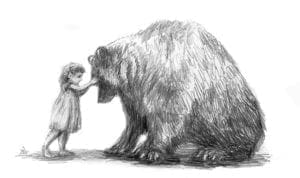The bear we have to cross
By LORRAINE V. MURRAY, Commentary | Published January 25, 2019
If there is such a thing as the opposite of a hoarder, then count me in. As far back as I can remember, I have enjoyed eagerly prowling through the house to find items to give away.
One day recently, I spotted something in the basement, covered with dust and hidden in a corner.
My mood brightened as I went over to pick it up and haul it upstairs, but I soon felt like the wolf in “The Three Little Pigs,” as I huffed and puffed and tried to budge the object, which resisted my every attempt.
The object, you see, was my cross, which had grown dusty and covered with cobwebs because I had tried ignoring it for so long.
Instead of picking it up each day and hefting it upon my shoulders, I ran away from it because I thought it was too big for me. As a result, it grew even heavier!
When I was a little girl and first heard the expression “the cross we have to bear,” I turned it around in my head, so it became “the bear we have to cross.”
In my mind, the notion of crossing the path of bear meant a big struggle, plenty of adrenaline—and hopefully, the ability to outrun the fellow.
 And this is how I often react to the suffering in my life—running fast and hoping it will get winded and stop pursuing me.
And this is how I often react to the suffering in my life—running fast and hoping it will get winded and stop pursuing me.
There is a story about a fifth-century Egyptian monk, Saint John the Dwarf, who was prone to anger and irritation, and at age 18 went into the desert to devote his life to Christ.
His spiritual mentor told John to plant his walking stick in the earth and water it every day, which entailed walking for hours each day to the river and back.
John obeyed and three years later, the stick budded, flowered and bore fruit, which his teacher shared with the other monks, calling it the fruit of obedience.
In “My Sisters the Saints,” Colleen Carroll Campbell writes about the years that she and her husband struggled with a deep longing for children that seemed impossible to satisfy.
One day she told her mother, “I can accept the cross of never having children. It’s the waiting, the not knowing, that’s driving me crazy.”
“The waiting is the cross,” her mother replied.
This was a brilliant answer, since many of us carry crosses that consist of anguishing about how long an unwanted situation will last.
Take the parents who pray for years for an adult child struggling with an addiction. Take someone watching a spouse’s slow decline into helplessness because of a dreadful illness. Take the widow who yearns for an end to loneliness.
“Maybe that was the truth I had overlooked all these years,” Campbell writes, “that the waiting, the not knowing, even the interior desolation and doubts—that was the suffering Jesus wanted me to offer up to him.”
She realized that Jesus wasn’t asking her to understand her cross, but rather to carry it, “to wake up each morning, bend a knee on the cold wooden floor beside my bed, and offer that day’s sufferings and joys for whatever purposes he wished to use them.”
Campbell’s story had a definite happy ending, because her prayers were answered and her patience rewarded—and today she and her husband have four children.
It doesn’t always work out this way, of course. Many people may spend a lifetime praying for something and never have the joy of receiving it.
So the big question is this: Can we show obedience to God by faithfully carrying whatever crosses he’s given us, even the ones that involve doubts, interior desolation and what seems like endless waiting?
Can we tell God, “Thy will be done” without also thinking, “and mine too”?
As for me, I dusted off the cross in the basement and managed to haul it upstairs, but I didn’t put it with the pile of items that would leave my life forever.
Instead, I prayed that I would, each morning, get down on my knees on the cold wooden floor and give my suffering to God to use as he sees fit.
I also hoped that with sufficient patience and prayer, perhaps this cross will someday miraculously flower and bear fruit.
Artwork is by Jef Murray. You may contact Lorraine at lorrainevmurray@yahoo.com.